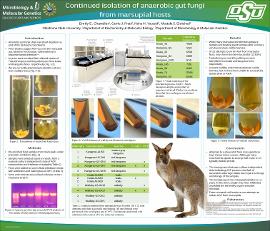| dc.contributor.advisor | Elshahed, Mostafa | |
| dc.contributor.author | Chandler, Emily E. | |
| dc.contributor.author | Pratt, Carrie J. | |
| dc.contributor.author | Youssef, Noha H. | |
| dc.date.accessioned | 2023-04-14T15:33:14Z | |
| dc.date.available | 2023-04-14T15:33:14Z | |
| dc.date.issued | 2023-04-18 | |
| dc.identifier | oksd_URS_2023_chandler | |
| dc.identifier.citation | Chandler, E. E., Pratt, C. J., Youssef, N. H., & Elshahed, M. S. (2023, April 18). Continued isolation of anaerobic gut fungi from marsupial hosts. Poster session presented at the Oklahoma State University Undergraduate Research Symposium, Stillwater, OK. | |
| dc.identifier.uri | https://hdl.handle.net/11244/337407 | |
| dc.description.abstract | Anaerobic gut fungi (AGF) are commonly found in the digestive tracts of herbivores, where they play a crucial role in breaking down complex plant materials, such as cellulose and lignin, by adhering to plant biomass and producing enzymes and bioactive molecules that break down these complex sugars. AGF are particularly important in ruminants, such as cows and sheep, but they have also been found in other herbivorous animals, including marsupials, reptiles, and birds. The presence of AGF in marsupials, which are non-placental mammals that diverged from placental mammals approximately 125 million years ago, is strongly supported by both microscopic and sequence-based evidence. Because marsupials diverged early from other mammals and have been geographically isolated, they may represent an untapped source of undiscovered AGF genera. Previous efforts from our lab have successfully isolated two different AGF genera from captive marsupials, Eutestudomyces from a koala, and Khoyollomyces from a red kangaroo. It is of note that both AGF genera are early branching within the phylum and represent some of the oldest known representatives. We obtained fresh fecal samples from several kangaroos and wallabies in Oklahoma and are currently attempting to cultivate and identify new strains of AGF from these samples. Our approach involves utilizing a rumen fluid-based media under rigorous anaerobic conditions that has been supplemented with plant substrates and antibiotics to inhibit the growth of unwanted organisms. A successful enrichment is indicated by the visible development of bubbles and fungal biomass and increased pressure within the tube. Successive rounds of subculturing and picking colonies from roll tubes ensures the isolation of individual strains. Continuing to isolate AGF from marsupials will provide greater insight into the diversity and biology of these microorganisms and open up new possibilities for their use in various fields such as veterinary medicine, biofuels, and biomedical engineering. | |
| dc.format | application/pdf | |
| dc.language | en_US | |
| dc.publisher | Oklahoma State University | |
| dc.rights | In the Oklahoma State University Library's institutional repository this paper is made available through the open access principles and the terms of agreement/consent between the author(s) and the publisher. The permission policy on the use, reproduction or distribution of the article falls under fair use for educational, scholarship, and research purposes. Contact Digital Resources and Discovery Services at lib-dls@okstate.edu or 405-744-9161 for further information. | |
| dc.title | Continued isolation of anaerobic gut fungi from marsupial hosts | |
| osu.filename | oksd_URS_2023_chandler.pdf | |
| dc.description.department | Biochemistry and Molecular Biology | |
| dc.description.department | Microbiology and Molecular Genetics | |
| dc.type.genre | Poster | |
| dc.type.material | Text | |
| dc.type.material | Image | |
| dc.subject.keywords | anaerobic gut fungi | |
| dc.subject.keywords | marsupials | |
| dc.subject.keywords | wallaby | |
| dc.subject.keywords | kangaroo | |
